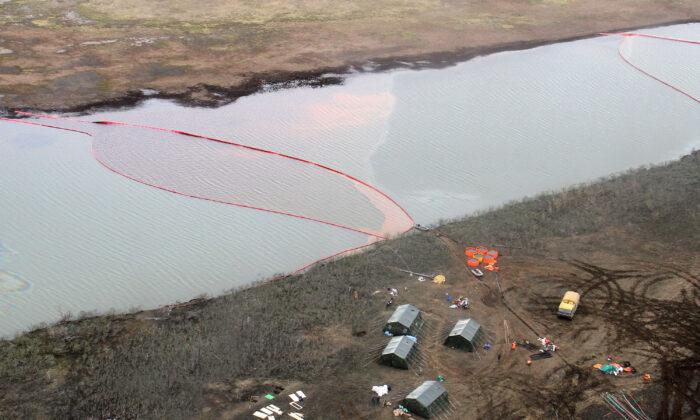Russian President Vladimir Putin declared a state of emergency in the Norilsk region after 20,000 metric tons (approx. 22,000 tons) of diesel spilled from a reserve fuel tank into a river system on May 29.
The Ambarnaya river flows into Lake Pyasino and the Pyasino river connects with the Kara Sea, which is part of the Arctic ocean.
The Emergency Ministry received information only two days after the leak occurred. A Marine Rescue Service unit reached the area on June 1 and delivered oil sorbets and oil booms at the mouth of the Ambarnaya River.
“Measures are being taken to localize the spread of the spill, oil booms have been installed, and work is underway to collect oil products, contaminated water, and soil,” Zinichev told Putin in a meeting on Wednesday.
The Federal state of emergency declared by Putin implies that federal resources will be provided for relief efforts, said his office.

Localizing the Consequences
Zinichev told Putin that the authorities are taking measures to localize the spread of the oil and 100 people from the Siberian Rescue Centre will be flown to the area of oil spill on Thursday.“Localising the consequences of the spill requires extensive work to collect oil products in the river and adjacent land. Currently, 100 tonnes of oil products and contaminated soil have been collected,” Zinichev told Putin.
The Russian State Fishing authorities said that the river system would take decades to recover and Dmitry Klokov, a spokesman for the Rosrybolovstvo state fishing agency described it as an ecological catastrophe.
An expanse of crimson water could be seen stretching from shore to shore down a river as well as an offshoot of the river in aerial footage posted online by the RIA news agency.
Norilsk, a remote city of 180,000 situated 300 km (190 miles) inside the Arctic Circle, is built around Norilsk Nickel, the world’s leading nickel and palladium producer.
The company says it is doing all it can to clean up the spill. It has brought in specialists from Moscow who have sectioned off the affected part of the river to stop pollution from spreading further.






Friends Read Free